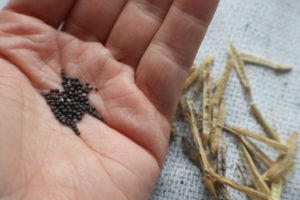Which seeds can I swap?
- Seeds from plants that do well in your garden or allotment – vegetable, flower, shrub, herbs… We do not wish to be inundated by hollyhocks, fennel or forget-me-not, (although they have their beauty!). More unusual plants are sought after.
- Seeds from healthy plants. They should be collected when ripe, as mature seeds contain more food which ensures vigour and viability ( potential for a high germination rate). The larger the seed, the better.
- Seeds that you have collected to preserve the genetic variety. It is best to save equal numbers of seeds from each healthy plant, rather than only saving seeds from the best plant. The latter is done if you want to develop your own varieties. Seedy Sunday is about preserving heirloom varieties.

What about F1Hybrids?
- We aim to avoid F1Hybrids, because seeds saved from those plants do not subsequently breed true to type, and it takes a long time to get a stable variety from F1 plants. Therefore we do not use them as our starter stock, nor do we wish to swap them. If you have some F1 seeds, you can experiment with producing your own varieties, but it is a complex and lengthy process…
How do I package the seeds?
Free envelopes are available from Infinity Foods in Brighton, or from the Seed Table on the day.
As a rough guideline, envelopes contain enough seeds for a small crop, for example a short row of peas, or beans, a square metre of salads… We advise 5 to 10 seeds per pack for tomatoes, 5 seeds for squashes, 20 to 25 seeds for peas and beans.
Labelling the pack should include name (common or Latin), variety (if applicable), year and place of collection. Example: Tomato – Rose de Berne – 2017 – Shoreham-by-sea.
I do not have any seeds to swap. What can I do?
- You can select any packets you want from the Seed Table, and give us a donation of 50p per pack instead. The money will be used to buy some fresh new starter stock for next year’s Seedy Sunday.
- Each year, we replenish our basic starter stock with open pollinated varieties from reputable suppliers, the main one being Moles Seeds. Some seeds are organic. We avoid treated seeds.

Do you have any tips for seed saving?
- On the day we will do some short demos on basic seed saving, and you can also discuss this with our volunteers at the seed table.
- Some seeds need to be fermented before being dried, for example tomatoes. This process ensures germination. Keep them in a jar of water for a few days. Rinse well and dry.
- All seeds to be dried should be thoroughly cleaned first, and the chaff and the unviable seeds sieved or removed before proper drying. In the case of broad bean seeds, they should be visually inspected for holes, and later stored in a freezer in order to kill any possible insect infestation.
- During ripening and drying on the plant, the seeds prepare for dormancy by converting sugars to more stable fats and starch. After that they can be safely dried and stored
- Drying should be gradual and thorough, shady spot, airy, dry (20% to 30% Relative humidity), for a couple of weeks, relatively to the size of the seeds. One easy way is to place the seeds in a jar of dry rice for a fortnight. The rice will gradually dry up the seeds. Dry corn and beans will shatter when hit with a hammer.
- Storing should be in dry, constant temperature and moisture, in an insect-free environment. You can store them in the fridge, or even a freezer, but gradually bring them back to room temperature before sowing.
Any more questions?
- Best not to swap squashes and pumpkin seeds (Cucurbits), unless the plants have been well isolated, as they cross-fertilize very easily, being a promiscuous lot! Use new stock of seeds instead.
- Some seeds can keep for several years, under favourable conditions, however, some, like parsnips, only keep for a year. Best to use seeds collected this year. Old seeds can always be used for a spot of guerilla gardening.
